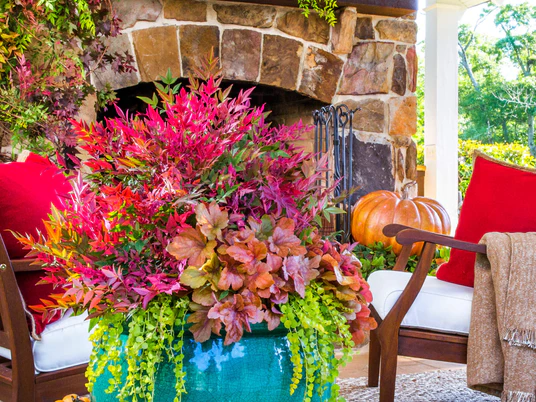Soft Caress Mahonia
Soft Caress Mahonia - 2.5 Quart is backordered and will ship as soon as it is back in stock.
Description
Description
Soft Caress Mahonia (Mahonia eurybracteata 'Soft Caress' PP20183) from the Southern Living Plant Collection is a truly exceptional shade plant! Chinese Mahonia was introduced years ago, and provided a solution for shaded gardens everywhere. However, the sharp foliage of the Chinese Mahonia requires gloves or a particularly careful touch, which makes pruning difficult. The "Soft Caress" removes this potentially painful aspect of the Mahonia entirely, with its soft feather-like foliage. The greenery resembles a fern frond type of growth pattern, and sprouts richly colored leaves that can range from light green to a dark blue-green.
Early in Winter, this variety develops brilliant and fragrant yellow flowers that crown the evergreen foliage. Following the blooms are clusters of silver-blue berries that are an unexpected change of pace for this one-of-a-kind, fascinating plant.
It reaches a mature size of 3' H x 3.5' W. Because of its dwarf size, it won't go wild and take over your landscape. Meanwhile, a naturally compact nature will leave pruning completely optional.
Try it in a mass planting in a shaded spot you don't want to worry about maintaining.
Furthermore, it's perfect for Asian-inspired gardens. Otherwise, try it as a short border in a shade garden, or as an accent in a container planter. You really can't go wrong with this Mahonia!
Soft Caress Mahonia Care
Hardy in USDA Zones 7-9, down to 0° Fahrenheit when established.
One of the most attractive aspects of the Soft Caress Mahonia is its ability to thrive in both Part Sun and Part Shade, an unusual feat for most flowering shrubs.
Plant in well-draining acidic soil for best results. Alkaline soils may lead to an iron deficiency and yellowing leaves. Therefore, planting in acidic to neutral soil is important.
Water 2-3 times a week during the first growing season. After your plant has a couple growing seasons under its belt, supplemental watering is only necessary in times of intense heat and drought.
Fertilize in early spring with a balanced, slow-release acidic plant fertilizer.
Recommended Companion Plants for the Soft Caress Mahonia
- Try this variety with some other shade-friendly plants, like the Everillo Carex and Florida Sunshine Anise. Both of these varieties have bright golden foliage that really brightens up shady spots. The Mountain Snow Pieris also handles shade well and features some gorgeous white bell-shaped blossoms in early spring.
- For partial shade plantings, consider planting it with some Hydrangeas, such as the Big Daddy Hydrangea or Bloomstruck Hydrangea. Their wide leaves and large rounded blooms contrast beautifully this Mahonia's feathery foliage.
Still looking for inspiration? Check out these Shade Garden Ideas.
Frequently Asked Questions:
"Is Soft Caress Mahonia deer-resistant?"
Traditional Mahonia are very deer resistant because of their thorny nature. The Soft Caress does not have thorns, therefore, it is not as deer resistant. However, it's not a deer's favorite snack. They will likely only nibble at it if other food is scarce.
"Why is my foliage turning yellow?"
- Your soil pH may be too high. When this happens, it can create an iron deficiency in your plant because it's unable to absorb nutrients properly. The result is that leaves may turn yellow and fall off over time. Pick up a soil pH test and take a sample from the base of your plant, several inches deep. If it shows up decently over a pH of 7, you should consider supplementing your soil with a soil acidifier, such as elemental sulfur.
- Your Mahonia might be getting too much sun. Mahonia can handle some sun very well, in fact, they look great with a couple to a few hours of direct sun. However, they aren't Full Sun plants. If yours are getting too much direct sunlight, they'll fade to a yellow-green to yellow and eventually, the plant might expire. Move them or figure out a way to give them more shade.
"Why isn't my Mahonia flowering?"
Mahonia can bloom from late fall to late winter, depending on the weather you're having and where it's planted. So our first suggestion would be to consider that it hasn't gotten around to it yet, or it may have bloomed already if you recently bought the plant. However, if fall and winter came and went without any flowers, there's likely something else at play. Dehydration is a common cause for a lack of flowers. Ensure that your plant is staying properly hydrated throughout the year. They need water to produce flowers and will often drop their flower buds if they are dehydrated for too long.
Care & Use
Care & Use
Spacing Recommendations
Spacing Recommendations
-
Scientific Name
-
Hardiness Zone7, 8, 9
-
Sun ExposurePart Sun to Part Shade
-
Evergreen or DeciduousEvergreen
-
FeaturesDwarf, Flowering, Shade Tolerant
-
Feature ColorGreen, Yellow
-
UsesAccent, Container, Mass Planting
-
Water NeedsMedium
-
Bloom SeasonWinter
Growing Zones : 7, 8, and 9


Southern Living Plants












